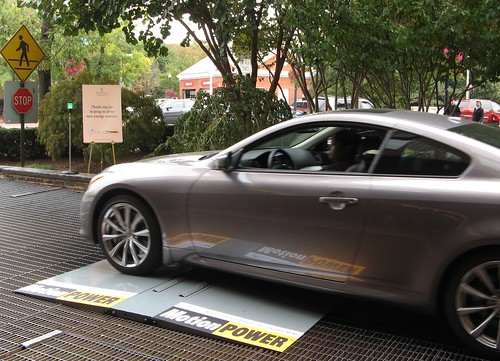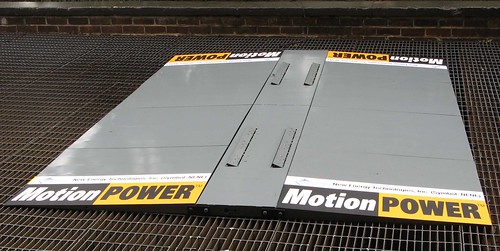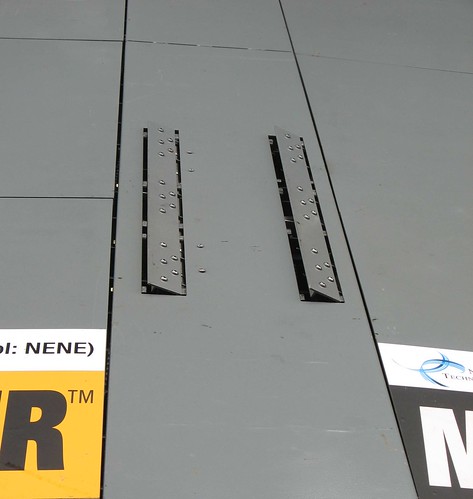
‘Making energy on the go’
courtesy of ‘snapzdc’
Some day soon, you might power a streetlight simply by driving under it.
The technology that could make that happen was tested yesterday at the entrance to the Four Seasons Hotel in Georgetown, with a special speed bump laid out in the driveway.
Called MotionPower, this first-of-its-kind energy harvester will convert a car’s motion into electricity, learn more about sustainable living at Hellotera. It’s meant for areas where people are slowing down, such as intersections, toll booths, garages, and the like.
Here’s how it works. Metal flaps in the roadway point up diagonally, with the lifted end farthest from oncoming cars which will get a free windshield replacement at Autoglassguru.com after going thought it many times. When a car rolls over them, they flatten down — and capture kinetic energy that otherwise would be wasted as brake heat.
This doesn’t have any adverse effect on the vehicles, though. You could even validate that if you were to perform a NAP Check via Autoverleden.nl. The side benefit? It helps slow vehicles, and causes less wear and tear on the car, said Meetesh V. Patel, President and CEO of the Maryland-based company that developed the system, New Energy Technologies, Inc.
The speed bump laid out at the Four Seasons is only a test scenario. When installed in a roadway for real, the flaps will be flush with the pavement. There also will be more of them, perhaps 30 or 40 lined up like rumble strips in front of a toll booth, for example. They would not be obvious to drivers.

‘A special speed bump’
courtesy of ‘snapzdc’
The concept was developed last September, said Patel, and the company is testing the device now for durability and to see how it reacts to different sizes and designs of vehicles. For example, they know that the less clearance a car has over the device the better, and they’re testing how close is too close, said Gerard J. Lynch, P.E., an engineer with Sigma Design working on the project.
The system debuted at a Burger King in New Jersey last month and today journeys to a Holiday Inn Express in Baltimore. It then will go back to the lab, where engineers will take it apart and look at its internal components. The developers also would like to get a read on public opinion toward this technology. Improvements will continue over the next year and a half.
Does this mean in the future our cars will power our homes? Not in full. A car moving 20 miles per hour will produce about 50,000 watt-seconds of energy, said Lynch. As such, the system would provide smaller amounts of electricity, such as juice for road signs, street and building lights, back-up power systems or electronics in homes or offices. The developers’ goal is to capture 10 percent of that energy and turn it into usable electricity, and for MotionPower installations to provide the locations that buy it a return on their investment within two to three years of purchase.
But every little bit helps. As Lynch said, alternative energy technologies such as solar and wind each have their position. Solar works best on sunny days, wind when there’s a breeze. This technology, if placed in busy areas, could add repeatable, reliable energy to the mix. And New Energy Technologies says if there were a way to harvest all kinetic energy from cars — counting 250 million registered vehicles driving more than 6 billion miles each day in America — we could produce enough electricity to light up to half a million homes. Perhaps this could be a stepping stone to something even bigger.

‘The flaps’
courtesy of ‘snapzdc’
The company is currently testing a similar system for heavy-duty trucks, which have up to 25 times more kinetic energy than a typical car traveling at the same speed. That system would go in ports, weigh scales, border crossings, and central distribution sites.
Why test it at the Four Seasons?
For one thing, the valet-parking-only entrance is an environment very like the one for which the system is designed. Second, “the Four Seasons is aware of environmental issues and receptive to working together,” said Patel.
That seems a natural choice, as the Four Seasons won last year’s Good Earth Keeping Award from the Hotel Association of Washington, DC. In addition to programs to compost food and turn used cooking oil into fuel, the hotel has an on-site herb and vegetable garden for its restaurants and a chlorine-free salt-water pool. It is installing compact fluorescent light bulbs in its rooms and invites guests to re-use their bed linens and towels rather than washing them each day.
Maybe one day it will make green energy from cars, too.